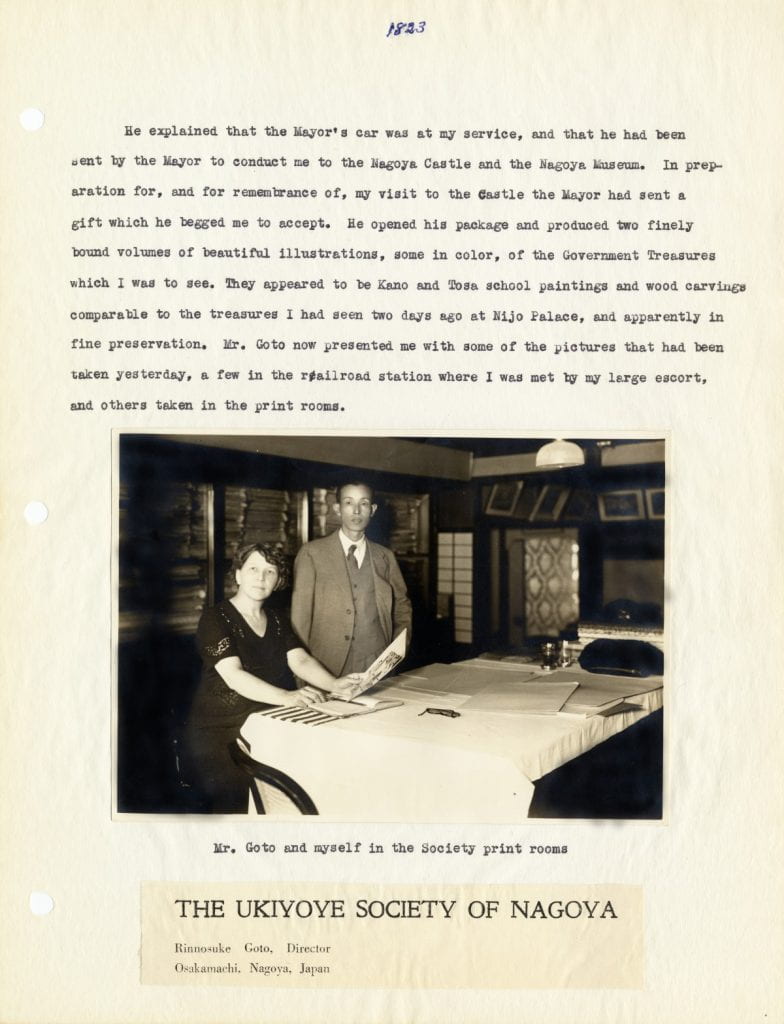 Between July 19th and September 6th, 1936 an adventurous art collector named Lilla S. Perry traveled to Japan and kept a diary about her trip. At some later date she typed up portions of her diary and correspondence, entitled it “A Treasure Hunt in Japan, 1936” and included many photos and pamphlets. She may have intended to eventually publish her story, or perhaps only share it with family and friends, but the unpublished typescript is now in the collection here at Amherst College. It was donated to the college in 2002 by William Green¹, a fellow art collector who had been acquainted with Mrs. Perry’s son, E. Caswell Perry.
Between July 19th and September 6th, 1936 an adventurous art collector named Lilla S. Perry traveled to Japan and kept a diary about her trip. At some later date she typed up portions of her diary and correspondence, entitled it “A Treasure Hunt in Japan, 1936” and included many photos and pamphlets. She may have intended to eventually publish her story, or perhaps only share it with family and friends, but the unpublished typescript is now in the collection here at Amherst College. It was donated to the college in 2002 by William Green¹, a fellow art collector who had been acquainted with Mrs. Perry’s son, E. Caswell Perry.
Lilla Perry was in her mid-50s at the time of her trip, lived in southern California and had become widowed a few years earlier. She was fascinated by the art form of Japanese woodblock prints known as ukiyo-e. Her son described her 1936 journey as a “print pilgrimage…visiting dealers and collectors and some museums, and finding many worthwhile prints, both old and new.”²
Besides her search for ukiyo-e, the manuscript is filled with fascinating and entertaining details of Mrs. Perry’s eighteen day voyage by freighter (for which she paid $140), and glimpses of Japan prior to World War II. Here are just a few:
 ◊ “On our way back to the hotel an open automobile passed us full of Geisha. They were like brilliant butterflies, and their elaborate head dresses – to our amazement – were encased in cellophane, that not a hair should be displaced by the wind! They were scattering handbills in all directions, one of which I salvaged and place here.”
◊ “On our way back to the hotel an open automobile passed us full of Geisha. They were like brilliant butterflies, and their elaborate head dresses – to our amazement – were encased in cellophane, that not a hair should be displaced by the wind! They were scattering handbills in all directions, one of which I salvaged and place here.”
 ◊ “It is only a few times in a lifetime that one meets a person like Miss Denton. I loved her instinctively from the first minute. Evidently she did me, too, for there seems to be nothing she would not do for me. Her kindness during this stay in Kyoto has been beyond measure. She is doubtless in her late eighties, but made of wire and steel. The Doshisha School has of late years been her life…”
◊ “It is only a few times in a lifetime that one meets a person like Miss Denton. I loved her instinctively from the first minute. Evidently she did me, too, for there seems to be nothing she would not do for me. Her kindness during this stay in Kyoto has been beyond measure. She is doubtless in her late eighties, but made of wire and steel. The Doshisha School has of late years been her life…”
 ◊ “Evening. Fujiya Hotel, Miyonoshita, Japan…I have been all over the charming hotel, particularly interested in the many elegant baths. I have talked with “the master of the inn,” Mr. Yamagouchi…He is a great talker, and I had good fun with him…and he told me all about his famous “Mustache Club” and showed me the gallery of photographs of its members.”
◊ “Evening. Fujiya Hotel, Miyonoshita, Japan…I have been all over the charming hotel, particularly interested in the many elegant baths. I have talked with “the master of the inn,” Mr. Yamagouchi…He is a great talker, and I had good fun with him…and he told me all about his famous “Mustache Club” and showed me the gallery of photographs of its members.”
A portion of “A Treasure Hunt in Japan” did eventually make its way into print. E. Caswell Perry published approximately half of the journal entries in 1978, seven years after his mother’s death, in a monograph of the Society for Japanese Arts and Crafts.³ But the original typescript is a wonderful example of the kind of primary resource that students are encouraged to work with in courses such as Professor Karen Sanchez-Eppler’s “The Unprinted Page: Working with Manuscripts” (English 415) (see the class blog).
¹For more information on William Green’s generous art donation to Amherst College’s Mead Museum, see the exhibition catalog Creative Transformations, available in the Frost Library stacks.
²Perry, E. Caswell, “Lilla S. Perry: A Retrospect,” Impressions: Official Publication of the Ukiyo-e Society of America, no. 14 (Spring 1988): 12.
³Perry, Lilla S., “A Treasure Hunt in Japan, 1936: Excerpts from the diary of Mrs. Lilla S. Perry,” in Ukiyo-e Studies and Pleasures, edited by H.M. Kaempfer (The Hague: Society for Japanese Arts and Crafts, 1978), 68-83.
Update! (1/27/2012) We now know that the majority of Lilla S. Perry’s journals are housed in the archives at the Huntington Library. Our thanks go to her grand-niece, Ann Delaney, who contacted us. She remembers her great aunt as “a steely but fascinating character. She later wrote a book about snuff bottles which is still considered a major source about that topic. She gave piano lessons to the children of many movie stars. As a child I was both frightened by and fascinated with her fantastic house in L.A. filled with all manner of Japanese antiquities.”
